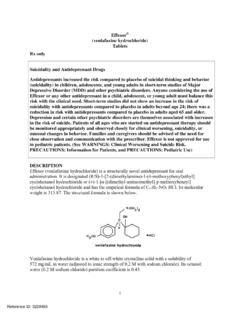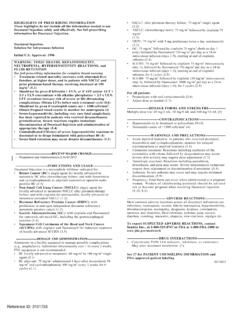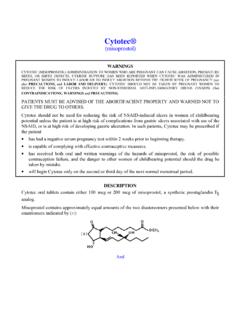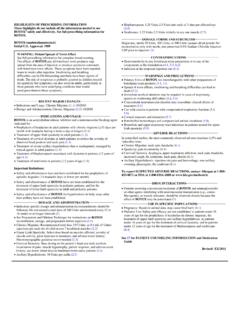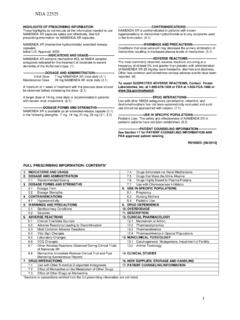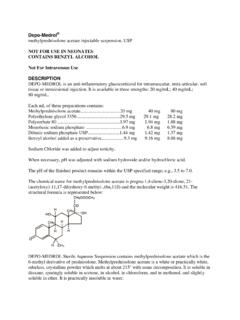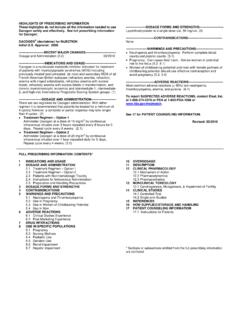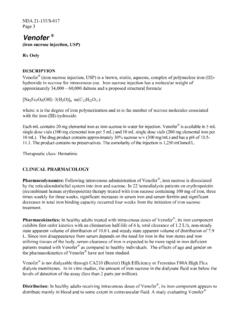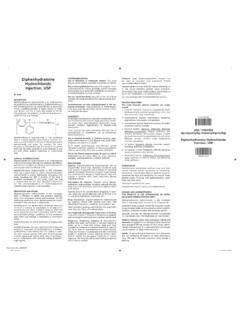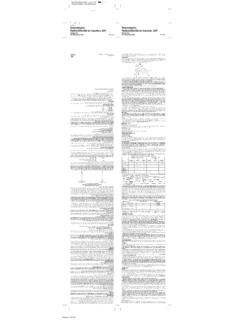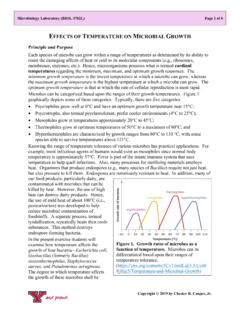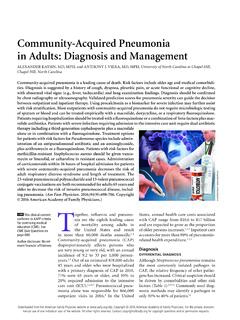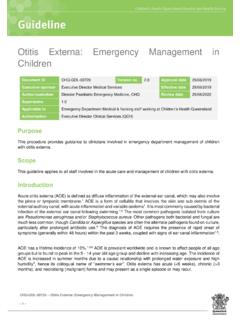Transcription of FOR INTRAVENOUS USE ONLY - Food and Drug …
1 NDA 50-706/S-022 Page 3 MERREM (meropenem for injection) FOR INTRAVENOUS USE ONLY To reduce the development of drug -resistant bacteria and maintain the effectiveness of MERREM (meropenem for injection) and other antibacterial drugs, MERREM should be used only to treat or prevent infections that are proven or strongly suspected to be caused by bacteria. DESCRIPTION MERREM (meropenem for injection) is a sterile, pyrogen-free, synthetic, broad-spectrum, carbapenem antibiotic for INTRAVENOUS administration.
2 It is (4R,5S,6S)-3-[[(3S,5S)-5-(Dimethylcarbam oyl)-3-pyrrolidinyl]thio]-6-[(1R)-1-hydr oxyethyl]-4-methyl-7-oxo-1-azabicyclo[ ]hept-2-ene-2-carboxylic acid trihydrate. Its empirical formula is C17H25N3O5S 3H2O with a molecular weight of Its structural formula is: MERREM is a white to pale yellow crystalline powder. The solution varies from colorless to yellow depending on the concentration. The pH of freshly constituted solutions is between and Meropenem is soluble in 5% monobasic potassium phosphate solution, sparingly soluble in water, very slightly soluble in hydrated ethanol, and practically insoluble in acetone or ether.
3 When constituted as instructed (see DOSAGE AND ADMINISTRATION; PREPARATION OF SOLUTION), each 1 g MERREM vial will deliver 1 g of meropenem and mg of sodium as sodium carbonate ( mEq). Each 500 mg MERREM vial will deliver 500 mg meropenem and mg of sodium as sodium carbonate ( mEq). CLINICAL PHARMACOLOGY At the end of a 30-minute INTRAVENOUS infusion of a single dose of MERREM in normal volunteers, mean peak plasma concentrations are approximately 23 g/mL (range 14-26) for the 500 mg dose and 49 g/mL (range 39-58) for the 1 g dose.
4 A 5-minute INTRAVENOUS bolus injection of MERREM in normal volunteers results in mean peak plasma concentrations of approximately 45 g/mL (range 18-65) for the 500 mg dose and 112 g/mL (range 83-140) for the 1 g dose. Following INTRAVENOUS doses of 500 mg, mean plasma concentrations of meropenem usually decline to approximately 1 g/mL at 6 hours after administration. In subjects with normal renal function, the elimination half-life of MERREM is approximately 1 hour. Approximately 70% of the intravenously administered dose is recovered as unchanged meropenem in the urine over 12 hours, after which little further urinary excretion is detectable.
5 Urinary NDA 50-706/S-022 Page 4 concentrations of meropenem in excess of 10 g/mL are maintained for up to 5 hours after a 500 mg dose. No accumulation of meropenem in plasma or urine was observed with regimens using 500 mg administered every 8 hours or 1 g administered every 6 hours in volunteers with normal renal function. Plasma protein binding of meropenem is approximately 2%. There is one metabolite that is microbiologically inactive. Meropenem penetrates well into most body fluids and tissues including cerebrospinal fluid, achieving concentrations matching or exceeding those required to inhibit most susceptible bacteria.
6 After a single INTRAVENOUS dose of MERREM , the highest mean concentrations of meropenem were found in tissues and fluids at 1 hour ( to hours) after the start of infusion, except where indicated in the tissues and fluids listed in the table below. Table 1. Meropenem Concentrations in Selected Tissues (Highest Concentrations Reported) Tissue Dose (g) Number of Samples Mean [ g/mL or g/(g)]* Range [ g/mL or g/(g)] Endometrium 7 Myometrium 15 Ovary 8 Cervix
7 2 Fallopian tube 9 Skin 22 Interstitial fluid 9 Skin 10 Interstitial fluid 5 Colon 2 Bile 7 (3)
8 H) Gall bladder 1 - Peritoneal fluid 9 Lung 2 (2 h) Bronchial mucosa 7 Muscle 2 6. 1 (2 h) Fascia 9 Heart valves 7 Myocardium 10 CSF (inflamed) 20 mg/kg 40 mg/kg 8 5 (2 h) (3 h) CSF (uninflamed) 4 (2 h)
9 *at 1 hour unless otherwise noted obtained from blister fluid in pediatric patients of age 5 months to 8 years in pediatric patients of age 1 month to 15 years The pharmacokinetics of MERREM in pediatric patients 2 years of age or older are essentially similar to those in adults. The elimination half-life for meropenem was approximately hours in pediatric patients of age 3 months to 2 years. The pharmacokinetics are linear over the dose range from 10 to 40 mg/kg. NDA 50-706/S-022 Page 5 Pharmacokinetic studies with MERREM in patients with renal insufficiency have shown that the plasma clearance of meropenem correlates with creatinine clearance.
10 Dosage adjustments are necessary in subjects with renal impairment. (See DOSAGE AND ADMINISTRATION - Use in Adults with Renal Impairment.) A pharmacokinetic study with MERREM in elderly patients with renal insufficiency has shown a reduction in plasma clearance of meropenem that correlates with age-associated reduction in creatinine clearance. Meropenem is hemodialyzable. However, there is no information on the usefulness of hemodialysis to treat overdosage. (See OVERDOSAGE.)
